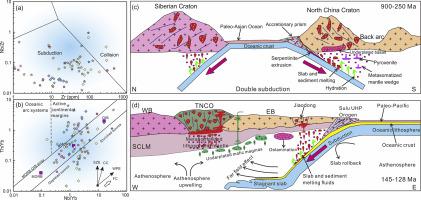Gondwana Research ( IF 7.2 ) Pub Date : 2021-03-13 , DOI: 10.1016/j.gr.2021.03.005 Fan Yang , Sung Won Kim , Toshiaki Tsunogae , Hongying Zhou

|
Numerous Late Paleozoic to Early Mesozoic mafic-ultramafic intrusions occur along the northern margin of the North China Craton (NCC). The timing, magma source, genetic types and tectonic evolution of these intrusions still remain controversial. Here we conduct a systematic petrological, mineral chemical, whole-rock geochemical, isotopic (zircon Lu–Hf and whole-rock Sr–Nd isotopes) and geochronological study on representative samples from the Chicheng ultramafic complex in the northern NCC, our results provide new insights into multiple melt-fluid interactions in the subcontinental lithospheric mantle through time. Zircon U–Pb data from the ultramafic rocks (pyroxenite and serpentinized dunite) show a wide range of ages (2721–129 Ma), indicating zircon growth within an evolving and metasomatized mantle wedge during multi-stage melt-fluid interactions. The youngest zircon population (145–129 Ma) possibly marks the timing of formation of the Chicheng ultramafic complex at the Early Cretaceous. Moreover, these ultramafic rocks also witnessed tectonic transition from Paleo-Asian Ocean to Paleo-Pacific Plate subduction during the Paleozoic to Early Mesozoic and subsequent progressive lithospheric thinning and craton destruction at the northern margin of the NCC, which is also attested by the newly discovered diorite porphyry dyke from this complex reported in this study with zircon U–Pb ages in the range of 447 to 128 Ma. Zircon Lu–Hf isotopic data show εHf(t) values in the range of −19.9 to +15.4 with TDM of 219–3012 Ma and TDMC of 240–3650 Ma. Whole-rock Sr–Nd isotopic data display εNd(t) values ranging from −12.3 to −1.6, indicating heterogenous sources involving both depleted mantle and reworked ancient crustal components. Whole-rock geochemical data show enrichment in LILEs (Rb, Sr, Ba, Pb) and depletion in HFSEs (Nb, Ta, Ti), with positive anomalies at Ba, K, Pb and Nd and strongly negative Zr and Ti anomalies, suggesting geochemical affinities related to subduction-related island arc setting within an active continental margin. Mineral chemical data on clinopyroxenes do not correspond to “Alaskan-type” affinities. Integrating geochemical, geochronological and isotopic studies from this study and those from previous studies related to the mafic-ultramafic complexes in the northern Hebei Province along the northern margin of the NCC, we propose that these complexes might be composite plutons formed during the Early Cretaceous, which were derived from the interaction of melts and fluids released from subducted slab with metasomatized mantle peridotite, triggering different degree of partial melting of mantle wedge.
中文翻译:

太古代至中生代成分对次大陆岩石圈地幔的富集:来自华北克拉通赤城超镁铁质复合体的证据
在华北克拉通(NCC)的北缘,发生了许多古生代到中生代早期的镁铁-超音波侵入。这些入侵的时间,岩浆源,遗传类型和构造演化仍存在争议。在这里,我们对北卡罗莱纳州北部赤城超镁铁质复合物的代表性样品进行了系统的岩石学,矿物化学,全岩石地球化学,同位素(锆石Lu–Hf和全岩石Sr–Nd同位素)和地质年代学研究,我们的结果提供了新的深入了解亚大陆岩石圈地幔中多种熔体-流体的相互作用。来自超镁铁质岩石(辉绿岩和蛇纹石的辉光岩)的锆石U–Pb数据显示出年龄范围很广(2721–129 Ma),表明在多阶段熔体-流体相互作用过程中,锆石在不断演化和交代的地幔楔内生长。最年轻的锆石种群(145–129 Ma)可能标志着早白垩世赤城超镁铁质复合体的形成时间。此外,这些超镁铁质岩石还经历了从古亚洲到古太平洋板块俯冲的构造过渡,从古生代到中生代,随后在NCC北缘岩石圈逐渐变薄和克拉通破坏,这也得到了新发现的证明。本研究报道了该复合物中的闪长斑岩脉,锆石的U–Pb年龄在447至128 Ma之间。Zircon Lu–Hf同位素数据显示εHf(t)值在-19.9到+15.4之间,其中T 最年轻的锆石种群(145–129 Ma)可能标志着早白垩世赤城超镁铁质复合体的形成时间。此外,这些超镁铁质岩石还经历了古生代到中生代的构造演化,从古亚洲洋向古太平洋板块俯冲,随后在NCC北缘岩石圈逐渐变薄和克拉通破坏,这也得到了新发现的证明。本研究报道了该复合物中的闪长斑岩脉,锆石的U–Pb年龄在447至128 Ma之间。Zircon Lu–Hf同位素数据显示εHf(t)值在-19.9到+15.4之间,其中T 最年轻的锆石种群(145–129 Ma)可能标志着早白垩世赤城超镁铁质复合体的形成时间。此外,这些超镁铁质岩石还经历了从古亚洲到古太平洋板块俯冲的构造过渡,从古生代到中生代,随后在NCC北缘岩石圈逐渐变薄和克拉通破坏,这也得到了新发现的证明。本研究报道了该复合物中的闪长斑岩脉,锆石的U–Pb年龄在447至128 Ma之间。Zircon Lu–Hf同位素数据显示εHf(t)值在-19.9到+15.4之间,其中T 这些超镁铁质岩层还经历了古生代到中生代早古亚洲从大洋向古太平洋板块的俯冲转变,随后在北卡罗来纳州北部边缘岩石圈逐渐变薄和克拉通破坏,新发现的闪长斑岩也证明了这一点。在这项研究中报道了该复合物中的锆石,锆石的U–Pb年龄在447至128 Ma之间。Zircon Lu–Hf同位素数据显示εHf(t)值在-19.9到+15.4之间,其中T 这些超镁铁质岩层还经历了古生代到中生代早古亚洲从大洋向古太平洋板块的俯冲转变,随后在北卡罗来纳州北部边缘岩石圈逐渐变薄和克拉通破坏,新发现的闪长斑岩也证明了这一点。在这项研究中报道了该复合物中的锆石,锆石的U–Pb年龄在447至128 Ma之间。Zircon Lu–Hf同位素数据显示εHf(t)值在-19.9到+15.4之间,其中TDM 219–3012 Ma和T DM C240-3650毫安。整个岩石的Sr–Nd同位素数据显示的εNd(t)值介于-12.3至-1.6之间,表明异质源涉及地幔耗尽和古代地壳组分的返工。全岩地球化学数据显示LILE富集(Rb,Sr,Ba,Pb)和HFSE耗竭(Nb,Ta,Ti),Ba,K,Pb和Nd呈正异常,而Zr和Ti呈强烈负异常。与活跃大陆边缘内与俯冲作用有关的岛弧环境有关的地球化学亲和力。斜柏基的矿物化学数据不符合“阿拉斯加型”亲和力。结合本研究和以前研究的地球化学,地质年代学和同位素研究,这些研究与河北省北部沿NCC北部的镁铁质-超镁铁质复合体有关,











































 京公网安备 11010802027423号
京公网安备 11010802027423号